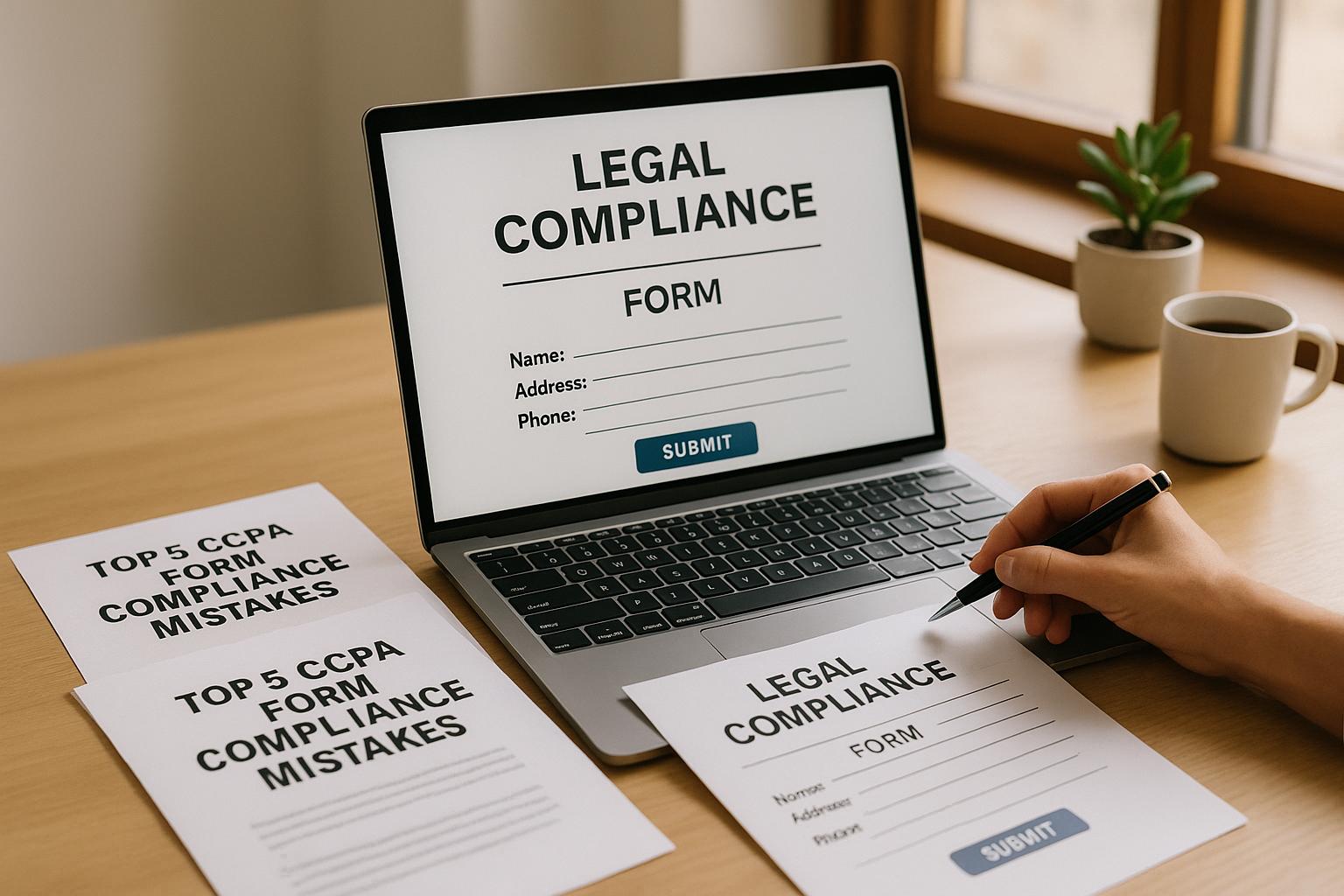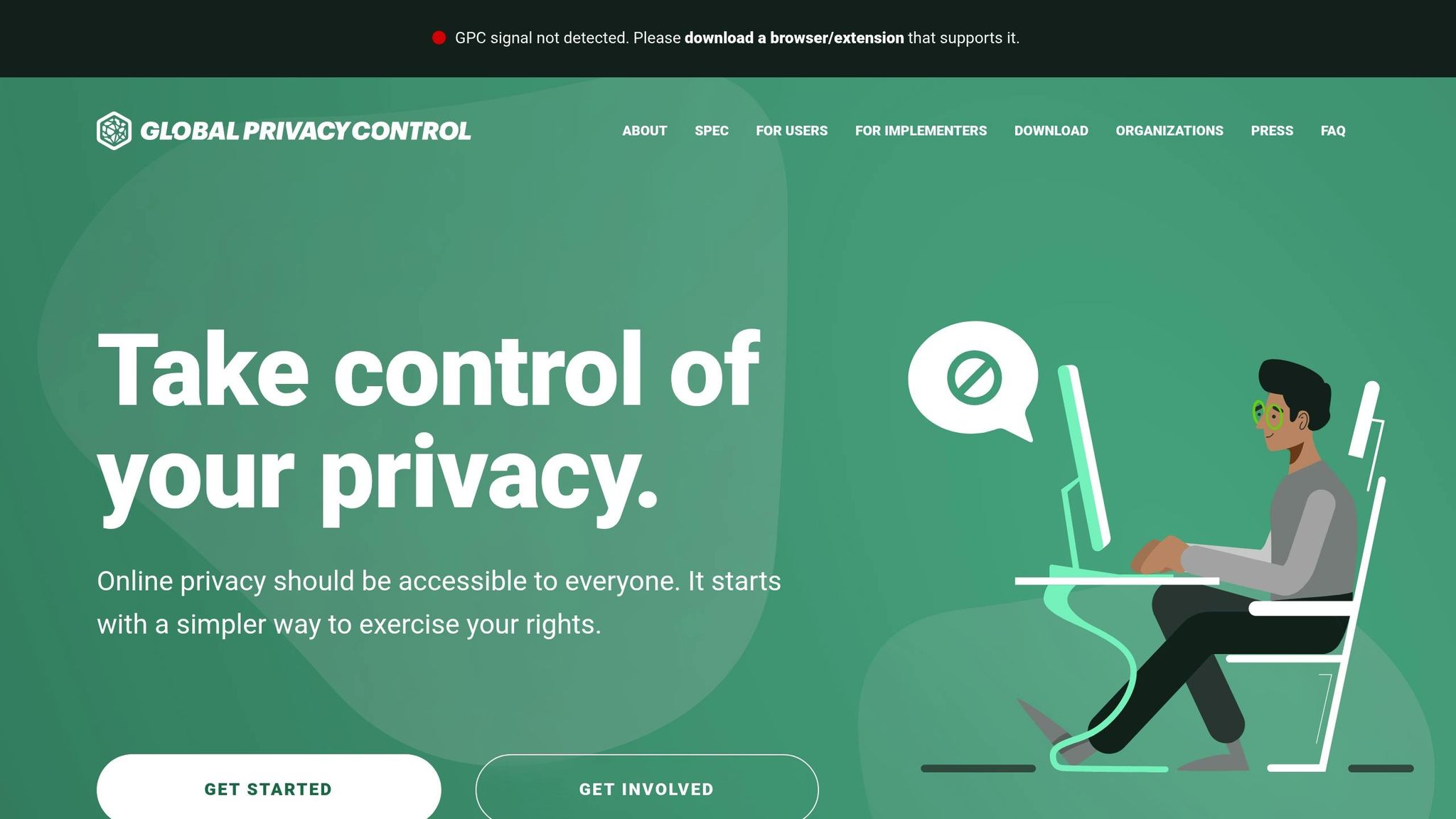Top 5 CCPA Form Compliance Mistakes

If your business collects personal data online, avoiding mistakes in CCPA compliance is essential. Noncompliance can lead to fines ranging from $2,663 to $7,988 per violation and damage your reputation. Here are the five most common mistakes businesses make with online forms under the CCPA:
- Missing or broken "Do Not Sell or Share My Personal Information" links: Links must be visible, functional, and process opt-out requests correctly.
- Incomplete privacy policies: Your policy must include all 12 required elements, such as data types collected, purposes, and consumer rights.
- Poor handling of consumer data requests: Requests must be acknowledged within 10 business days and fulfilled within 45 calendar days, with minimal data collection for verification.
- Ignoring Global Privacy Control (GPC) signals: Businesses must honor automated opt-out signals or risk penalties.
- Collecting excessive personal data: Only collect the minimum data necessary for each request to comply with data minimization rules.
Avoiding these errors requires regular audits, testing compliance tools, and ensuring your processes align with CCPA requirements. Businesses like Sephora and Tractor Supply have faced fines exceeding $1 million for these oversights. Take action now to protect your business and build trust with your customers.
California Privacy Laws, Decoded: Why CCPA and the DELETE Act Still Set the Pace
1. Missing or Broken "Do Not Sell or Share" Links
One of the most important - and often overlooked - requirements of the CCPA is providing a working "Do Not Sell or Share My Personal Information" link. This is a legal obligation that must be both easy to find and fully functional.
Visibility and Functionality Matter
Under the CCPA, businesses are required to display this opt-out link prominently on their homepage and in their privacy policy. The language used must be specific and compliant, such as "Do Not Sell or Share My Personal Information", "Your Privacy Choices", or "Your California Privacy Choices". Burying the link in hard-to-find places, like footers, or using vague wording can make it harder for consumers to exercise their rights.
However, visibility is only part of the equation. The link also needs to work seamlessly, processing opt-out requests immediately with reliable backend systems. A visible but broken link is just as problematic as having no link at all.
Handling Opt-Out Requests Correctly
Beyond making the link accessible, businesses must ensure that opt-out requests are handled properly. If the mechanism for opting out doesn't work as intended, it can lead to serious consequences. For example, in 2022, Sephora faced a $1.2 million settlement over allegations that included a non-functional "Do Not Sell" link. Even if third-party tools are used to manage these requests, the business is still responsible for ensuring everything operates correctly.
Regular testing is critical. Issues often come to light only after consumers file complaints, but by then, businesses may already face penalties. Fines for violations can range from $2,663 to $7,988 per incident. To avoid these costly mistakes, businesses should:
- Verify that the link is visible on all relevant pages.
- Use CCPA-compliant language.
- Test the functionality to ensure requests are processed successfully.
Documenting these testing efforts can also demonstrate a genuine commitment to compliance if regulators come knocking.
For companies using no-code tools like Reform, it’s crucial to test opt-out mechanisms across all devices and browsers to ensure a smooth experience for every user.
2. Incomplete Privacy Policies
When it comes to meeting CCPA compliance, your privacy policy isn’t just a formality - it’s a critical tool. Yet, many businesses fall short by using outdated templates or overlooking essential details, leaving themselves vulnerable to penalties.
Accuracy and Completeness of Privacy Disclosures
Under the CCPA, privacy policies must include 12 specific elements, and missing even one can spell trouble for your business. These disclosures need to clearly explain the types of personal information collected, the reasons for collection, consumer rights, how to exercise those rights, and either specific data retention periods or a clear methodology for determining them.
Vagueness won’t cut it. Instead of saying, "we collect personal information", your policy should specify whether that includes names, email addresses, IP addresses, or browsing habits. Consumers need clarity, and so do regulators.
Take the case of Tractor Supply Company in 2023. The company faced a $1.35 million settlement after regulators determined its privacy policies didn’t provide enough detail for consumers to understand their rights or how the company complied with CCPA requirements. This misstep resulted in one of the most significant CCPA enforcement actions to date.
Proper Handling of Consumer Requests
Your privacy policy also needs to spell out how consumers can exercise their rights, with clear and functional pathways. This includes working contact details, response timeframes, and step-by-step instructions that make the process straightforward.
For example, if your policy states that consumers can submit requests via a web form, that form must function seamlessly across all devices and browsers. Businesses using tools like Reform should regularly test these forms to ensure they work as intended. A broken or confusing process can escalate a simple compliance task into a costly violation.
Additionally, privacy policies must be updated annually or whenever there are material changes to data practices. Relying on outdated or generic templates is a common mistake that leaves businesses exposed as regulations evolve. This is why many companies are turning to automated privacy policy management to reduce the risk of human error and outdated disclosures.
3. Poor Handling of Consumer Data Requests
Addressing the challenges of form functionality and privacy policy details, it's equally crucial to manage consumer data requests properly. Once a consumer submits a data request through your forms, the stakes rise significantly, and mishandling these requests can lead to hefty violations.
Proper Handling of Consumer Requests
Under the CCPA, businesses must follow strict timelines: acknowledge consumer data requests within 10 business days and provide a full response within 45 calendar days. If more time is needed, a single 45-day extension is allowed, but the consumer must be notified of the delay.
Failing to meet these deadlines isn’t just bad customer service - it’s a compliance violation. Each missed deadline is treated as a separate infraction, with fines ranging from $2,663 to $7,988 per violation. On top of that, manual processing of requests can cost over $1,000 each, factoring in staff hours, system access, legal reviews, and coordination across departments.
A cautionary tale comes from Todd Snyder, Inc., which incurred a $345,178 fine for mishandling opt-out submissions and demanding excessive verification from consumers. This underscores the importance of having a smooth, efficient system for managing consumer requests.
Clear Visibility and Functionality of Compliance Elements
Your compliance tools, like consumer request forms, must work seamlessly across all devices and browsers. On May 1, 2025, the California Privacy Protection Agency (CPPA) issued a public enforcement action, fining a business nearly $350,000 for multiple violations. These included webforms that collected unnecessary personal information and failed to authenticate users properly.
The CPPA pointed out that these issues could have been avoided with proper website monitoring. Instead, the company relied on third-party tools without verifying their effectiveness. Regular audits of your systems are essential to catch and fix these kinds of problems before they escalate into costly penalties.
If you're using tools like Reform to build consumer request forms, test them regularly across various devices and browsers to ensure they function correctly. A poorly designed or broken process can turn a straightforward compliance task into a major liability.
Recognition and Honoring of Opt-Out Signals
A common error businesses make is treating all consumer requests the same. For example, opt-out requests don’t require verification under the CCPA, yet many companies still collect personal information for these requests unnecessarily .
Your systems must differentiate between verifiable requests (like accessing or deleting personal data) and non-verifiable ones (such as opting out of the sale or sharing of data). Each type of request should trigger the appropriate verification process, ensuring only the minimal amount of information is collected.
Adherence to Data Minimization Principles
Verification processes should align with the sensitivity of the data involved. Progressive disclosure is key - request only the information needed at each step of verification. The California Privacy Protection Agency’s Enforcement Advisory 2024-01 highlights that the principle of data minimization applies to all purposes related to collecting, using, retaining, and sharing personal data, including verification.
To avoid costly errors, document your compliance efforts thoroughly. Regularly test links and forms, maintain records that demonstrate active monitoring of tools, and train your staff to distinguish between different types of consumer requests. Human error remains a significant risk in privacy compliance, so proper training is critical to reducing mistakes. By mastering these verification requirements, you’ll also be better equipped to recognize and respond to broader privacy signals sent by consumers through their browsers.
sbb-itb-5f36581
4. Not Recognizing Global Privacy Control (GPC) Signals

Failing to acknowledge Global Privacy Control (GPC) signals is a major compliance issue for businesses. GPC is an automated signal that allows consumers to opt out of having their personal data sold or shared. Despite its importance, a staggering 75% of businesses are non-compliant with GPC requirements. Ignoring these signals not only undermines consumer trust but also exposes companies to significant penalties.
Understanding and Honoring Opt-Out Signals
GPC has fundamentally changed how consumers exercise their privacy rights. When enabled, it automatically sends an opt-out signal to websites, signaling users' preferences not to be tracked.
However, many businesses fall short in implementing this correctly. A study of over 5,000 websites found that non-compliant sites still activated three or more tracking cookies, even when GPC was enabled. This means that consumers who explicitly opted out were still being tracked and their data shared with third parties.
The consequences for ignoring GPC are steep. The California Privacy Protection Agency (CPPA) has been actively enforcing compliance. In one case, a business was fined nearly $350,000 for failing to honor opt-out requests. Following the Todd Snyder settlement, CPPA Head of Enforcement Michael Macko emphasized:
"Using a consent management platform doesn't get you off the hook for compliance. The buck stops with the businesses that use them".
Ensuring Visibility and Functionality of Compliance Tools
Cookie consent tools must be properly configured to recognize and act on GPC signals. The Todd Snyder case revealed significant lapses, such as cookie banners disappearing prematurely and delaying opt-out processing by 40 days.
The CPPA determined that Todd Snyder's failure stemmed from relying too heavily on third-party tools without verifying their functionality. They concluded that the company "would have known that Consumers could not exercise their CCPA right if the company had been monitoring its Website, but [the company] instead deferred to third-party privacy management tools without knowing their limitations or validating their operation".
The takeaway? Compliance cannot be outsourced. Businesses must actively test their systems to ensure they work as intended. Regular testing, including enabling GPC on different browsers and devices, is critical to catching and fixing issues before they result in fines.
Following Data Minimization Standards
Once a GPC signal is detected, all tracking and data sharing - whether through analytics cookies or advertising pixels - must immediately stop.
The financial risks of non-compliance are immense. Fines range from $2,663 to $7,988 per violation. For businesses handling large volumes of consumer data, these fines can quickly add up to millions of dollars.
To avoid these penalties, businesses need to take proactive steps. If you're using tools like Reform to manage forms, ensure they respect GPC signals. Regular audits and testing are essential to confirm that third-party tools are functioning as expected. Taking these steps can save your business from costly fines and protect consumer trust.
5. Collecting Too Much Personal Data
Over-collecting personal data is a common and costly compliance mistake. Despite clear regulations, many businesses still gather more information than necessary, violating the California Privacy Protection Agency's (CPPA) data minimization rules. This misstep often leads to fines and regulatory scrutiny.
Stick to Data Minimization Principles
Under the California Consumer Privacy Act (CCPA), companies are required to collect only the data needed for a specific purpose. Ignoring this principle can result in significant penalties.
Take Honda, for example. The company paid $632,500 in settlement fees, partly because it required government-issued ID photos for all consumer requests - even opt-out requests, which don't require verification under CCPA. The CPPA ruled that Honda's practices breached data minimization rules by demanding unnecessary information.
In another case from May 2025, the CPPA fined a business nearly $350,000 for asking consumers to submit a photo of themselves holding an ID to process CCPA rights via a web form. This practice collected excessive sensitive data and failed to distinguish between types of requests.
The main takeaway? Many businesses misunderstand CCPA requirements. For instance, opt-out requests - where consumers ask companies to stop selling or sharing their data - don’t require identity verification. Requiring something like a driver’s license for these requests is unnecessary and violates compliance standards.
Managing Consumer Requests the Right Way
Beyond minimizing data collection, businesses must also handle consumer requests carefully. CCPA differentiates between verifiable consumer requests, such as data access or deletion, and opt-out requests, which require no verification at all.
The enforcement trend is clear: collecting sensitive information like driver's licenses for opt-out requests is a breach of CCPA rules. To stay compliant, businesses should regularly audit their data collection practices. Identify the minimum information needed for each type of request. For opt-out requests, this often means just an email address or basic contact details.
Smarter Forms and Better Compliance
To meet compliance standards while improving user experience, businesses can use advanced form tools with features like multi-step forms and conditional logic. These tools ensure only the necessary data is collected at each stage. Platforms like Reform simplify this process, reducing form fatigue by asking for additional details only when absolutely necessary. Not only does this approach align with CCPA guidelines, but it also boosts conversion rates, as shorter forms are more likely to be completed.
Michael Macko, Head of Enforcement at the CPPA, highlighted the importance of active oversight following the Todd Snyder settlement:
"Using a consent management platform doesn't get you off the hook for compliance. The buck stops with the businesses that use them".
This underscores the need for businesses to test their compliance tools regularly. Forms should work as intended across all devices and browsers, collecting only the data outlined in your privacy policies.
Another useful strategy is leveraging lead enrichment technologies. These tools pull certain data from external sources, reducing the need to ask users for excessive details. By adopting these practices, businesses can ensure compliance with CCPA while providing a smoother, more user-friendly experience.
Conclusion
Failing to comply with CCPA form requirements can lead to hefty financial penalties and damage to consumer trust. Common pitfalls include broken or missing "Do Not Sell or Share" links, incomplete privacy policies, mishandling consumer data requests, ignoring Global Privacy Control signals, and collecting more personal data than necessary. These errors have already resulted in significant penalties across industries.
For example, enforcement actions have led to settlements like Sephora's $1.2 million, Tractor Supply's $1.35 million, and Todd Snyder's $345,178 fines. Beyond fines, operational costs can skyrocket for businesses managing numerous consumer inquiries. Missing deadlines can trigger additional penalties, ranging from $2,663 to $7,988 for each violation.
Regulators now expect businesses to implement fully functional compliance systems. Regular audits and testing across various devices are critical to avoid penalties. The California Privacy Protection Agency has made it clear that simply having a privacy policy or relying on third-party tools is not enough to ensure compliance.
The good news? Businesses can close compliance gaps with proper planning and the right tools. Solutions like automated consumer request management and no-code form builders with features like conditional logic and lead enrichment can significantly reduce risks and operational expenses. Reform, for instance, addresses these common errors by streamlining form functionality and prioritizing data minimization. By using a comprehensive tool like Reform, businesses can meet CCPA requirements while also improving their conversion rates.
FAQs
What happens if a business ignores Global Privacy Control (GPC) signals under CCPA?
Failing to comply with Global Privacy Control (GPC) signals under the California Consumer Privacy Act (CCPA) can have serious repercussions. Companies risk regulatory fines, potential lawsuits, and damage to their reputation by ignoring these signals, which allow users to opt out of the sale or sharing of their personal information.
Beyond being a legal requirement, honoring GPC signals is a chance to earn consumer trust. Respecting these privacy preferences shows a company’s dedication to transparency and responsible data practices. This not only helps strengthen customer relationships but also minimizes the likelihood of facing penalties.
How can businesses make sure their 'Do Not Sell or Share My Personal Information' links are easy to find and work properly?
To make your "Do Not Sell or Share My Personal Information" links effective, start by placing them in a spot that's easy for users to find - like your website footer or a dedicated privacy page. The label should be clear and straightforward so users immediately understand its purpose.
The link should take users directly to a simple form where they can submit their requests without any hassle. Regularly test the link to ensure it's functioning properly and meets CCPA guidelines. Also, make sure the form works seamlessly on mobile devices and is accessible to everyone, including individuals with disabilities.
How can businesses reduce data collection to meet CCPA compliance?
To meet CCPA requirements, businesses should prioritize collecting only the information they genuinely need for their specific purposes. Including unnecessary or irrelevant fields in forms can not only complicate compliance but also erode user trust.
Leveraging tools with features like customizable forms and selectable fields can simplify the process. These tools help ensure you're gathering just the essential data, aligning with CCPA guidelines. Plus, streamlined forms create a smoother, more user-friendly experience by keeping things straightforward and focused.
Related Blog Posts
Get new content delivered straight to your inbox

The Response
Updates on the Reform platform, insights on optimizing conversion rates, and tips to craft forms that convert.
Drive real results with form optimizations
Tested across hundreds of experiments, our strategies deliver a 215% lift in qualified leads for B2B and SaaS companies.


.webp)



